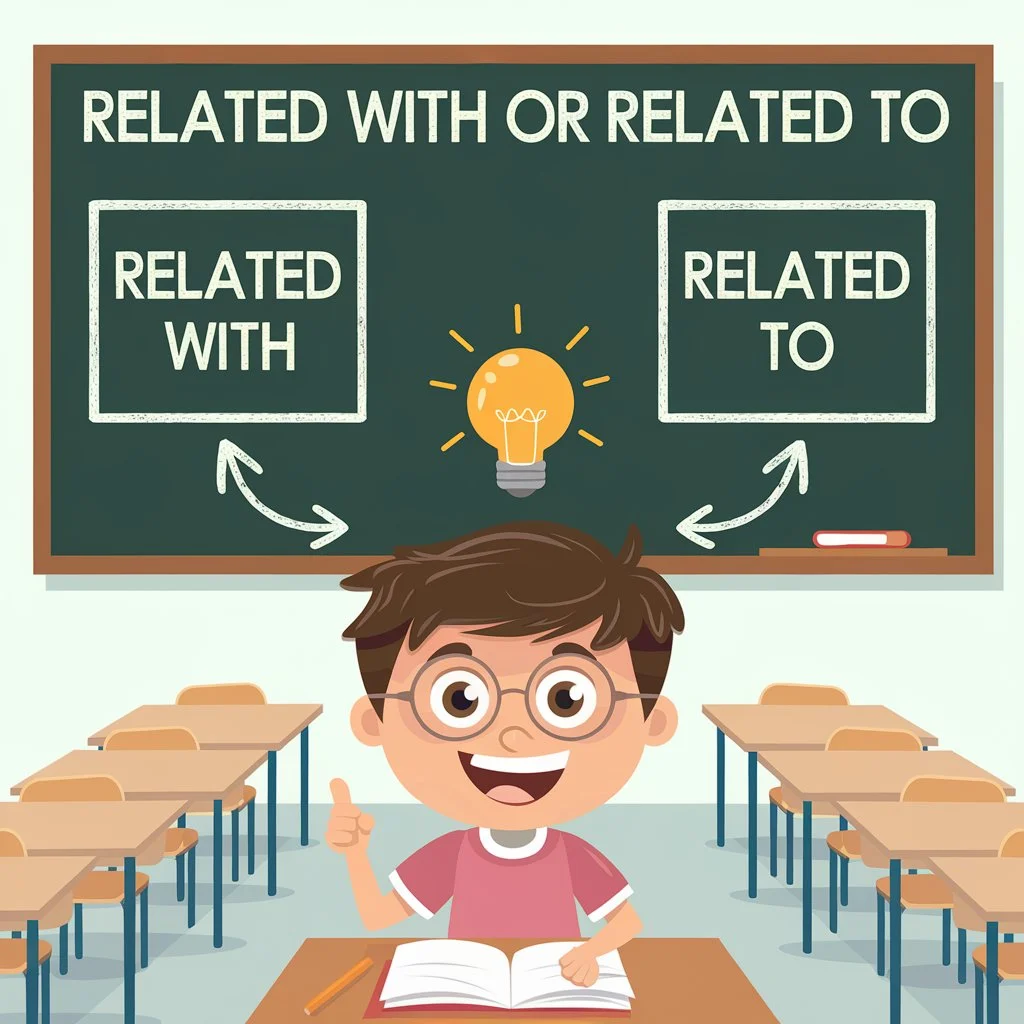Choosing between “related with” or “related to” can be confusing, especially if you’re unsure about the rules. Prepositions may seem small and harmless, but they play a big role in how we understand sentences. Even the tiniest mistake in word choice can leave readers puzzled or even change the meaning of your sentence entirely.
So, how do you know which one to use? This article will walk you through the difference between “related with” and “related to,” showing you when to use each one, and why. By the end, you’ll have clear rules, examples, and tips to help you avoid this common grammar pitfall.
Understanding the Basics: “Related With” vs. “Related To”
What Does “Related To” Mean?
Let’s start with the phrase that’s most commonly used: “related to.” When we say something is “related to,” we mean that there’s a connection between two things. This is the grammatically correct and widely accepted way to show that two things share a relationship, whether that’s by topic, cause, or effect.
For example:
- “This problem is related to our lack of resources.”
- “His success is related to the hard work he put in.”
In both sentences, “related to” shows the connection between two ideas. It tells us what the issue or success is tied to or linked with. It’s easy, straightforward, and what you’ll see most often in formal and informal writing.
Is “Related With” Ever Correct?
Now, let’s talk about “related with.” It’s not as commonly used and is generally considered less formal or incorrect in many cases. While it might sound okay to some people, it doesn’t follow the traditional grammar rules for showing relationships between ideas.
For example, compare these two sentences:
- “This problem is related to our lack of resources.”
- “This problem is related with our lack of resources.”
The second sentence sounds awkward and off, right? That’s because “related with” doesn’t follow the usual pattern in English for showing connections between ideas. While some may use it casually in conversation, it’s not recommended in professional or formal writing.
Why Is “Related To” Preferred?
The phrase “related to” is preferred because it’s the proper preposition in this context. The preposition “to” often shows direction or connection, which makes sense when you’re talking about two related ideas. For instance:
- “Related to” is similar to phrases like “connected to” or “linked to,” which also use “to” to show a relationship.
- On the other hand, “with” is usually used to show togetherness or accompaniment (as in, “I went to the movies with my friends”).
When you say something is “related to,” you’re showing a direct connection between two things. This is why “related to” is almost always the right choice.
Why “Related To” is Preferred in Standard English
“Related To” in Professional Writing
When it comes to formal writing, especially in professional or academic contexts, “related to” is the clear winner. Whether you’re writing an email, a report, or a presentation, using the correct preposition is essential to making your message clear and precise.
For example, let’s say you’re writing a business email:
- Correct: “This issue is related to the feedback we received from clients.”
- Incorrect: “This issue is related with the feedback we received from clients.”
Using “related to” shows that you understand the structure of English grammar and helps your writing look more polished and professional. In contrast, “related with” sounds clunky and can make you seem unsure about proper usage.
Prepositions in English Grammar
Prepositions are small words that pack a punch. They show relationships between words in a sentence, like direction, place, time, or relationship. Some common prepositions are to, with, in, on, at, and for.
Here’s how “to” and “with” are used:
- “To” is often used when we’re talking about movement or direction:
- “I am going to the store.”
- “He is giving the book to her.”
- It also shows relationships:
- “The problem is related to the product launch.”
- “With” is used to show things happening together:
- “I went shopping with my friend.”
- “She cooked dinner with her mom.”
In the case of “related to,” the preposition “to” is the proper choice because it shows the connection or link between two things.
“Related To” in Common Usage
In everyday writing and speech, you’ll notice that people almost always use “related to.” Whether it’s in casual conversation, emails, or articles, this is the standard way to express relationships between things. For instance:
- “The movie’s plot is related to a true story.”
- “Her concerns are related to her job.”
Even though “related with” might pop up in informal speech or certain regional dialects, it’s not considered correct in standard English.
Exploring Common Grammar Mistakes: Why “Related With” is Confusing
Why Do People Confuse “Related With” and “Related To”?
One of the reasons people sometimes use “related with” instead of “related to” is because prepositions can be tricky in English. English learners and even native speakers can get confused because with is commonly used in other phrases like:
- “Involved with”
- “Associated with”
These phrases use “with” correctly to show involvement or companionship. However, “related” is one of those words that pairs with “to” to show a connection.
Common Grammar Mistakes with Prepositions
Prepositions are easy to mix up because they often don’t follow hard-and-fast rules. They change depending on the verb, noun, or adjective they’re used with. Here are a few other common preposition mix-ups:
- “Different from” vs. “Different than”:
- The correct usage is “different from,” but some people say “different than.”
- “Interested in” vs. “Interested on”:
- It should be “interested in,” but some may mistakenly use “on.”
- “Talk to” vs. “Talk with”:
- Both are correct, but “talk to” is more common when you’re delivering a message, while “talk with” shows a two-way conversation.
Knowing which preposition to use can be tough, but it gets easier with practice!
How to Avoid This Mistake
The easiest way to avoid mixing up “related with” and “related to” is to always remember:
- “Related to” is almost always the correct choice.
- Think of “to” as showing direction or connection between two ideas.
When you’re unsure, try to replace the phrase with “connected to” or “linked to.” If it works, then “related to” is also the right choice.
How to Remember the Rule: Easy Tips
Tip 1: Think of “To” as a Connector
When you’re stuck trying to remember whether to use “related with” or “related to,” think of “to” as a connector between two things. Just like you’d say, “connected to,” you should also say “related to.”
For example:
- “The information is connected to the data.”
- “The information is related to the data.”
This simple comparison can help you remember that “to” is the right preposition when showing relationships between two things.
Tip 2: Avoid “With” in Formal Writing
As a general rule, try to avoid using “related with” altogether, especially in formal or professional writing. While it might slip into casual conversation, “related with” is not considered correct in standard English.
Tip 3: Practice with Examples
The best way to remember which preposition to use is through practice. Write sentences where you use “related to” and compare them with sentences using “related with.” You’ll quickly see that “related to” feels natural, while “related with” feels awkward.
Practical Examples: Using “Related To” in Sentences
In Professional Writing
In business or formal settings, using the correct preposition is key to making your writing clear and effective. Here are some examples of how to use “related to” in a professional context:
- “This issue is related to the feedback we received.”
- “Her concerns are related to the project timeline.”
- “The discussion was related to the company’s future plans.”
In Everyday Conversation
Even in everyday speech, “related to” is the preferred phrase. Here are some common examples:
- “This book is related to the history of ancient Egypt.”
- “My question is related to the presentation.”
- “His career choices are related to his passion for technology.”
Notice how “related to” flows naturally in all of these sentences, and how using “related with” would sound off or unnatural.
Prepositions in English: General Guidelines for Better Writing
The Importance of Prepositions
Prepositions are small words, but they have a big impact on your writing. They help connect ideas, show relationships, and clarify the meaning of your sentences. Choosing the right preposition is important, especially when you’re writing in a formal or professional setting.
Common Preposition Mistakes
Preposition mistakes can confuse your reader and weaken your message. Here are some other common preposition errors:
- “She is interested on science.” (Incorrect)
- “She is interested in science.” (Correct)
- “This solution is different than that one.” (Incorrect)
- “This solution is different from that one.” (Correct)
Tips for Mastering Prepositions
To avoid common preposition mistakes, try these tips:
- Learn the Patterns: Some prepositions always go with certain verbs or adjectives (like “interested in” or “related to”).
- Practice: Write out sentences and compare them to examples in grammar guides or online resources.
- Read Often: The more you read, the more natural prepositions will become to you. Pay attention to how they are used in books, articles, and even emails.
FAQs
Is “Related With” Ever Correct?
While “related with” might be used in casual or informal speech, it’s not considered correct in formal or standard English. Stick to “related to” for professional and clear writing.
Why Is “Related To” More Common?
“Related to” follows English grammar rules and is the standard phrase for showing a connection between two things. It’s preferred in both formal and informal contexts.
Can “Related With” Be Used in Informal Settings?
Although some people might use “related with” in conversation, it’s still better to use “related to” even in informal settings. This will help avoid confusion and keep your language consistent.
Are There Other Phrases Similar to “Related With”?
Yes, phrases like “associated with” or “involved with” are correct and commonly used. The preposition “with” works here because it shows being involved together with something, but “related” always pairs with “to.”
Conclusion
Choosing between “related with” and “related to” doesn’t have to be confusing. As we’ve seen, “related to” is the correct and preferred phrase in both formal and informal writing. It’s important to use the right preposition because it helps make your writing clear and easy to understand.
By following the tips in this article, you’ll never second-guess yourself again when deciding between “related with” and “related to.” Just remember: “related to” shows the connection between two ideas, while “related with” doesn’t quite fit. Stick with “related to” for polished, professional writing, and you’ll be on the right track!

It’s Elara Winters, your guide at “Grammer Grove.” I’ve dived into the intricacies of crafting the perfect English writing sections for your project, research paper, or thesis. With a wealth of experience in this field, I’m here to help you express gratitude and appreciation effectively. Join me on this journey, and let’s make your English writings shine!












